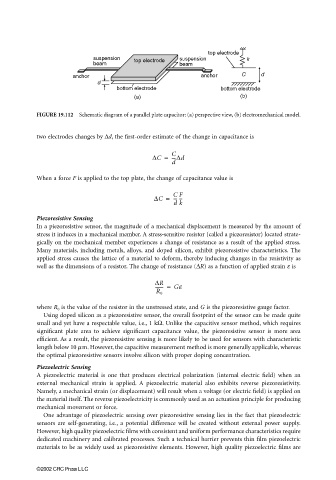Page 517 - The Mechatronics Handbook
P. 517
0066_frame_C19 Page 139 Wednesday, January 9, 2002 5:32 PM
FIGURE 19.112 Schematic diagram of a parallel plate capacitor: (a) perspective view, (b) electromechanical model.
two electrodes changes by ∆d, the first-order estimate of the change in capacitance is
∆C = C
---∆d
d
When a force F is applied to the top plate, the change of capacitance value is
∆C = C F
--- ---
d k
Piezoresistive Sensing
In a piezoresistive sensor, the magnitude of a mechanical displacement is measured by the amount of
stress it induces in a mechanical member. A stress-sensitive resistor (called a piezoresistor) located strate-
gically on the mechanical member experiences a change of resistance as a result of the applied stress.
Many materials, including metals, alloys, and doped silicon, exhibit piezoresistive characteristics. The
applied stress causes the lattice of a material to deform, thereby inducing changes in the resistivity as
well as the dimensions of a resistor. The change of resistance (∆R) as a function of applied strain ε is
∆R
------- = Ge
R 0
where R 0 is the value of the resistor in the unstressed state, and G is the piezoresistive gauge factor.
Using doped silicon as a piezoresistive sensor, the overall footprint of the sensor can be made quite
small and yet have a respectable value, i.e., 1 kΩ. Unlike the capacitive sensor method, which requires
significant plate area to achieve significant capacitance value, the piezoresistive sensor is more area
efficient. As a result, the piezoresistive sensing is more likely to be used for sensors with characteristic
length below 10 mm. However, the capacitive measurement method is more generally applicable, whereas
the optimal piezoresistive sensors involve silicon with proper doping concentration.
Piezoelectric Sensing
A piezoelectric material is one that produces electrical polarization (internal electric field) when an
external mechanical strain is applied. A piezoelectric material also exhibits reverse piezoresistivity.
Namely, a mechanical strain (or displacement) will result when a voltage (or electric field) is applied on
the material itself. The reverse piezoelectricity is commonly used as an actuation principle for producing
mechanical movement or force.
One advantage of piezoelectric sensing over piezoresistive sensing lies in the fact that piezoelectric
sensors are self-generating, i.e., a potential difference will be created without external power supply.
However, high quality piezoelectric films with consistent and uniform performance characteristics require
dedicated machinery and calibrated processes. Such a technical barrier prevents thin film piezoelectric
materials to be as widely used as piezoresistive elements. However, high quality piezoelectric films are
©2002 CRC Press LLC

